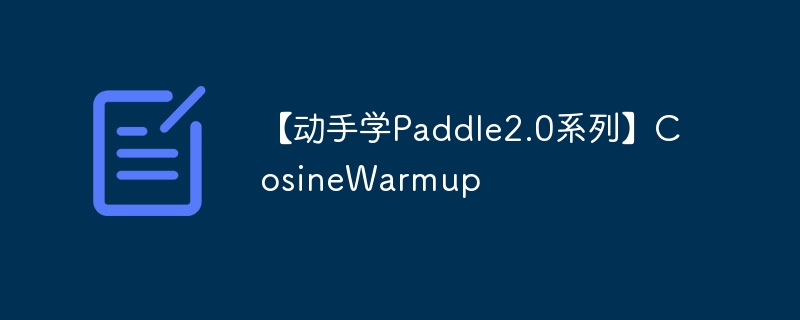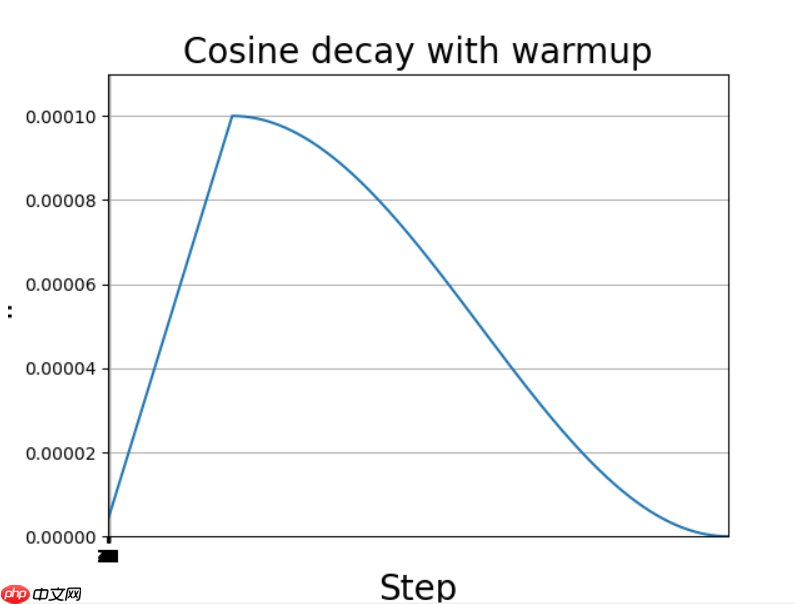本文介绍CosineWarmup训练策略的实战教程,含理论与代码。理论部分说明Warmup(学习率预热,初始用小学习率再调大)和余弦退火策略(依余弦函数降学习率)。代码用Paddle实现,模型为LeNet - 5,数据是Cifar10,展示了数据加载、模型构建、配置及训练评估过程。
☞☞☞AI 智能聊天, 问答助手, AI 智能搜索, 免费无限量使用 DeepSeek R1 模型☜☜☜

CosineWarmup是一种非常实用的训练策略,本次教程将带领大家实现该训练策略。教程将从理论和代码实战两个方面进行。
在代码实战部分,模型采用LeNet-5模型,数据采用Cifar10数据集,
Warmup最早出现于这篇文章中:Accurate, Large Minibatch SGD:Training ImageNet in 1 Hour
consine learning rate则来自于这篇文章Bag of Tricks for Image Classification with Convolutional Neural Networks
一般情况下,只在前五个Epoch中使用Warmup,并且通常情况下,把warm up和consine learning rate一起使用会达到更好的效果。
Warmup是在ResNet论文中提到的一种学习率预热的方法,它在训练开始的时候先选择使用一个较小的学习率,训练了一些epoches或者steps(比如4个epoches,10000steps),再修改为预先设置的学习来进行训练。由于刚开始训练时,模型的权重(weights)是随机初始化的,此时若选择一个较大的学习率,可能带来模型的不稳定(振荡),选择Warmup预热学习率的方式,可以使得开始训练的几个epoches或者一些steps内学习率较小,在预热的小学习率下,模型可以慢慢趋于稳定,等模型相对稳定后再选择预先设置的学习率进行训练,使得模型收敛速度变得更快,模型效果更佳。
当我们使用梯度下降算法来优化目标函数的时候,当越来越接近Loss值的全局最小值时,学习率应该变得更小来使得模型尽可能接近这一点,而余弦退火(Cosine annealing)可以通过余弦函数来降低学习率。余弦函数中随着x的增加余弦值首先缓慢下降,然后加速下降,再次缓慢下降。这种下降模式能和学习率配合,以一种十分有效的计算方式来产生很好的效果。

from paddle.optimizer.lr import LinearWarmupfrom paddle.optimizer.lr import CosineAnnealingDecayclass Cosine(CosineAnnealingDecay):
"""
Cosine learning rate decay
lr = 0.05 * (math.cos(epoch * (math.pi / epochs)) + 1)
Args:
lr(float): initial learning rate
step_each_epoch(int): steps each epoch
epochs(int): total training epochs
"""
def __init__(self, lr, step_each_epoch, epochs, **kwargs):
super(Cosine, self).__init__(
learning_rate=lr,
T_max=step_each_epoch * epochs, )
self.update_specified = Falseclass CosineWarmup(LinearWarmup):
"""
Cosine learning rate decay with warmup
[0, warmup_epoch): linear warmup
[warmup_epoch, epochs): cosine decay
Args:
lr(float): initial learning rate
step_each_epoch(int): steps each epoch
epochs(int): total training epochs
warmup_epoch(int): epoch num of warmup
"""
def __init__(self, lr, step_each_epoch, epochs, warmup_epoch=5, **kwargs):
assert epochs > warmup_epoch, "total epoch({}) should be larger than warmup_epoch({}) in CosineWarmup.".format(
epochs, warmup_epoch)
warmup_step = warmup_epoch * step_each_epoch
start_lr = 0.0
end_lr = lr
lr_sch = Cosine(lr, step_each_epoch, epochs - warmup_epoch) super(CosineWarmup, self).__init__(
learning_rate=lr_sch,
warmup_steps=warmup_step,
start_lr=start_lr,
end_lr=end_lr)
self.update_specified = Falseimport paddleimport paddle.nn.functional as Ffrom paddle.vision.transforms import ToTensorfrom paddle import fluidimport paddle.nn as nnprint(paddle.__version__)
2.0.2
transform = ToTensor()
cifar10_train = paddle.vision.datasets.Cifar10(mode='train',
transform=transform)
cifar10_test = paddle.vision.datasets.Cifar10(mode='test',
transform=transform)# 构建训练集数据加载器train_loader = paddle.io.DataLoader(cifar10_train, batch_size=64, shuffle=True)# 构建测试集数据加载器test_loader = paddle.io.DataLoader(cifar10_test, batch_size=64, shuffle=True)Cache file /home/aistudio/.cache/paddle/dataset/cifar/cifar-10-python.tar.gz not found, downloading https://dataset.bj.bcebos.com/cifar/cifar-10-python.tar.gz Begin to download Download finished
class MyNet(paddle.nn.Layer):
def __init__(self, num_classes=10):
super(MyNet, self).__init__()
self.conv1 = paddle.nn.Conv2D(in_channels=3, out_channels=32, kernel_size=(3, 3), stride=1, padding = 1) # self.pool1 = paddle.nn.MaxPool2D(kernel_size=2, stride=2)
self.conv2 = paddle.nn.Conv2D(in_channels=32, out_channels=64, kernel_size=(3,3), stride=2, padding = 0) # self.pool2 = paddle.nn.MaxPool2D(kernel_size=2, stride=2)
self.conv3 = paddle.nn.Conv2D(in_channels=64, out_channels=64, kernel_size=(3,3), stride=2, padding = 0) # self.DropBlock = DropBlock(block_size=5, keep_prob=0.9, name='le')
self.conv4 = paddle.nn.Conv2D(in_channels=64, out_channels=64, kernel_size=(3,3), stride=2, padding = 1)
self.flatten = paddle.nn.Flatten()
self.linear1 = paddle.nn.Linear(in_features=1024, out_features=64)
self.linear2 = paddle.nn.Linear(in_features=64, out_features=num_classes) def forward(self, x):
x = self.conv1(x)
x = F.relu(x) # x = self.pool1(x)
# print(x.shape)
x = self.conv2(x)
x = F.relu(x) # x = self.pool2(x)
# print(x.shape)
x = self.conv3(x)
x = F.relu(x) # print(x.shape)
# x = self.DropBlock(x)
x = self.conv4(x)
x = F.relu(x) # print(x.shape)
x = self.flatten(x)
x = self.linear1(x)
x = F.relu(x)
x = self.linear2(x) return x# 可视化模型cnn2 = MyNet() model2 = paddle.Model(cnn2) model2.summary((64, 3, 32, 32))
--------------------------------------------------------------------------- Layer (type) Input Shape Output Shape Param # =========================================================================== Conv2D-1 [[64, 3, 32, 32]] [64, 32, 32, 32] 896 Conv2D-2 [[64, 32, 32, 32]] [64, 64, 15, 15] 18,496 Conv2D-3 [[64, 64, 15, 15]] [64, 64, 7, 7] 36,928 Conv2D-4 [[64, 64, 7, 7]] [64, 64, 4, 4] 36,928 Flatten-1 [[64, 64, 4, 4]] [64, 1024] 0 Linear-1 [[64, 1024]] [64, 64] 65,600 Linear-2 [[64, 64]] [64, 10] 650 =========================================================================== Total params: 159,498 Trainable params: 159,498 Non-trainable params: 0 --------------------------------------------------------------------------- Input size (MB): 0.75 Forward/backward pass size (MB): 25.60 Params size (MB): 0.61 Estimated Total Size (MB): 26.96 ---------------------------------------------------------------------------
{'total_params': 159498, 'trainable_params': 159498}# 配置模型from paddle.metric import Accuracy
scheduler = CosineWarmup(
lr=0.5, step_each_epoch=100, epochs=8, warmup_steps=20, start_lr=0, end_lr=0.5, verbose=True)
optim = paddle.optimizer.SGD(learning_rate=scheduler, parameters=model2.parameters())
model2.prepare(
optim,
paddle.nn.CrossEntropyLoss(),
Accuracy()
)# 模型训练与评估model2.fit(train_loader,
test_loader,
epochs=10,
verbose=1,
)The loss value printed in the log is the current step, and the metric is the average value of previous step. Epoch 1/3
/opt/conda/envs/python35-paddle120-env/lib/python3.7/site-packages/paddle/fluid/layers/utils.py:77: DeprecationWarning: Using or importing the ABCs from 'collections' instead of from 'collections.abc' is deprecated, and in 3.8 it will stop working return (isinstance(seq, collections.Sequence) and
step 782/782 [==============================] - loss: 1.9828 - acc: 0.2280 - 106ms/step Eval begin... The loss value printed in the log is the current batch, and the metric is the average value of previous step. step 157/157 [==============================] - loss: 1.5398 - acc: 0.3646 - 35ms/step Eval samples: 10000 Epoch 2/3 step 782/782 [==============================] - loss: 1.7682 - acc: 0.3633 - 106ms/step Eval begin... The loss value printed in the log is the current batch, and the metric is the average value of previous step. step 157/157 [==============================] - loss: 1.7934 - acc: 0.3867 - 34ms/step Eval samples: 10000 Epoch 3/3 step 782/782 [==============================] - loss: 1.3394 - acc: 0.4226 - 105ms/step Eval begin... The loss value printed in the log is the current batch, and the metric is the average value of previous step. step 157/157 [==============================] - loss: 1.4539 - acc: 0.3438 - 35ms/step Eval samples: 10000
以上就是【动手学Paddle2.0系列】CosineWarmup的详细内容,更多请关注php中文网其它相关文章!

每个人都需要一台速度更快、更稳定的 PC。随着时间的推移,垃圾文件、旧注册表数据和不必要的后台进程会占用资源并降低性能。幸运的是,许多工具可以让 Windows 保持平稳运行。

Copyright 2014-2025 https://www.php.cn/ All Rights Reserved | php.cn | 湘ICP备2023035733号